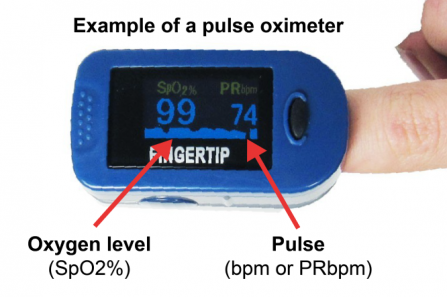COVID-19 Positive – How To Use An Adult Oximeter
IMPORTANT : The following information has been supplied by The Health Navigator New Zealand website - a trusted source of information. Asthma NZ recommend this advice is wise advice for those in our community who have respiratory conditions and if in doubt at all, PLEASE speak with us further here and if you are in an emergency situation DIAL 111.

What is a oximeter?
A pulse oximeter is a small device that fits on your finger and quickly and easily checks your oxygen levels and heart rate.
A pulse oximeter is a small device that fits on your finger and quickly and easily checks your oxygen levels and heart rate.
Note: The information on this page is for the use of a pulse oximeter in adults. For use in children, see how to use a pulse oximeter in children.
A pulse oximeter can be used to help monitor a range of conditions in hospital or at home, including COVID-19 infection.
COVID-19 is a viral infection. For most people, the symptoms are relatively mild, and they usually get better over 2 to 3 weeks. However, for some, the symptoms can be very serious and can get worse quickly.
If you are advised to monitor your symptoms and breathing, then the use of a health and symptom diary can help you and your healthcare team track any changes. This page will explain how to use a pulse oximeter, what the numbers mean and what actions you should take.
What does a pulse oximeter look like?

A pulse oximeter is a small, painless device that clips onto your finger and uses light beams in a sensor to estimate the amount of oxygen in your blood without taking a blood sample. This helps to track and assess how well your lungs are working.
A pulse oximeter measures 2 things:
- Pulse – this is a measure of how fast your heart is beating. Your pulse is measured in beats per minute (bpm). On your device this number may show as bpm or PRbpm (pulse rate/beats per minute).
- Oxygen saturation level – this is a measure of how much oxygen is in your blood. Your oxygen saturation is measured as a percentage (scored out of 100). On your device this number may show as SpO2% (saturation percentage of oxygen).
| If at any time you experience shortness of breath at rest or difficulty breathing, or your symptoms become suddenly worse, call 111 for an ambulance. |
|---|
How to use a pulse oximeter
There are different brands of these devices – please read the manufacturer's instructions. The following is a general guide. Ask your healthcare team if you have any questions.
| How to use a pulse oximeter – a general guide |
Preparing
Taking your reading
Recording your numbers
|
What do pulse oximeter numbers mean?
Your healthcare team will give you details on appropriate oxygen saturation levels for your specific medical condition. The following is a guide for adults with no previous lung conditions.
| Oxygen saturation SpO2% |
Pulse rate (bpm or PRbpm) | Action |
| 95–99 | 50–99 | ✔ Acceptable |
| 92–94 | 100 –119 | Seek advice from your COVID-19 healthcare team |
| Below 92 | 120 or more | Call 111 for urgent medical care |
|
If your oxygen saturation number drops by 3 (ie, decreases by 3 %) or more from your first reading, phone the 24-hour COVID-19 number 0800 358 5453. |
||
Other signs or symptoms of low oxygen levels
Do not rely only on a pulse oximeter to assess your health condition or oxygen level. It is only a measurement device.
Other signs or symptoms of low oxygen levels are:
- bluish colouring in your face, lips or nails
- shortness of breath, difficulty breathing or a cough that gets worse
- restlessness and discomfort
- chest pain or tightness
- fast or racing pulse rate.
If you have any concerns or questions, contact your healthcare team directly.
|
If at any time you experience any of the symptoms above, or your symptoms become suddenly worse, call 111 for an ambulance. |
Learn more
Pulse oximetry British Lung Foundation, UK
References
- Pulse oximetry American Thoracic Society, US
- Pulse oximeter accuracy and limitations Food and Drug Administration, US
- Remote management of covid-19 using home pulse oximetry and virtual ward support British Medical Journal, 2021


